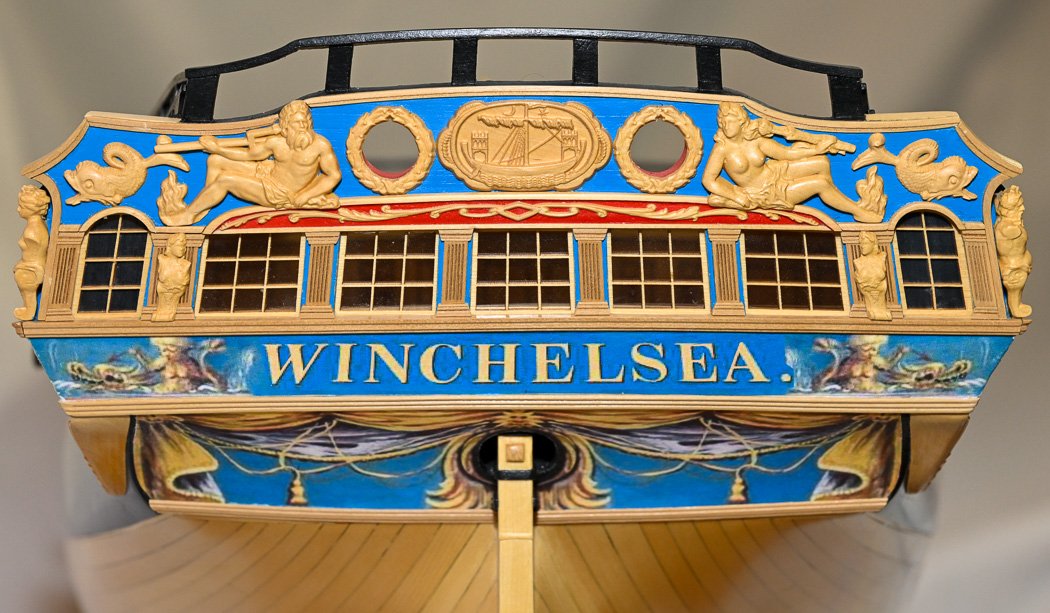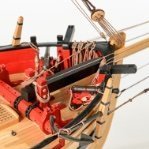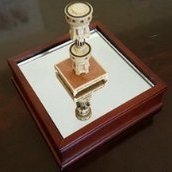HOLIDAY DONATION DRIVE - SUPPORT MSW - DO YOUR PART TO KEEP THIS GREAT FORUM GOING! (83 donations so far out of 49,000 members - C'mon guys!)
×
-
Posts
4,121 -
Joined
-
Last visited
Reputation Activity
-
 glbarlow got a reaction from EricWilliamMarshall in HM Cutter Cheerful 1806 by glbarlow - FINISHED - 1:48
glbarlow got a reaction from EricWilliamMarshall in HM Cutter Cheerful 1806 by glbarlow - FINISHED - 1:48
There were a number of things about building Cheerful I’d never done or seen before. In the case of the square tuck I didn’t even know what one was. Fortunately @Chuck instructions are clear enough - I just dove in and took it a step at a time.
I’d already made it challenging by not leaving enough of a gap between the bottom layer of the of the square tuck and the counter. So I filed and sanded until what once was a 1/32 backing triangle was now equal in thickness to a communion wafer. I elected to use 3/32 wood for the square tuck itself instead of recommended 1/8 for a better fit.
Step one is adding the center piece and the two top pieces, that was pretty easy, if only I could stop there.
And then the fun begins, I got a little involved and forgot to take a lot of photos. The next step is shaping a solid piece to fit against the top and center pieces, lightly attach it to my wafer thin backing with just two small drops of CA, then shape it to fit flush and follow the flow of the bottom of the hull. My recently acquired foam sanders in different shapes came in handy. Of course the key is to sand the piece flush but not go through the bottom of the already sanded hull, which I managed not to do.
With it sanded smooth and a flush fit, using 180, 220, and finally 320 sandpaper, I pried it off with pair of pliers...not... Actually very carefully with an extremely thin putty blade. I marked a 1/8th line along the curve using my digital caliper and a series of marks as I moved it around the outside of the curve. I don’t have a scroll saw, I was able to rough out the curve with my #11 blade, one benefit of using the thinner 3/32 wood I suppose. I cut away from the line and then carefully sanded it down to the 1/8 mark - measuring the top flat part of the wood. The sanded slant doesn’t matter and is not included in the 1/8.
With both sides complete I attached them permanently and began the process of filling them with 3/16 wide planks cut from the 3/32 wood (although plank width, regular planks are too thin). I didn’t take any photos of that process. I first sanded the top angle to match the top piece (I never changed that angle on my Byrnes Sander so it was easy to match). then measured the two lengths of the bottom angle to fit….and yes while 10 planks are fitted, more than 10 were cut - my scrap pile got a little taller. I also used my phatic glue and cedar saw dust to fill in gaps. There was only one, otherwise I was perfect. I can say that because they are all nicely filled and no one can tell now…ok there were two…ok more than two.
All sterns are different, mine being no exception - I had to use a piece of 6mm wide (about 1-2mm wider than 3/16 wood) for the teeny tiny triangle of the outer most piece to fill the gap. This is the mindset I have been able to adjust to, differing from kits. I have a lot of uncut wood in various thicknesses, I’m not limited to what’s in the kit - so I needed wider piece I cut a wider piece.
And now I have a square tuck, though I still don’t know what’s square about it. It's not perfect. Once I finished mine I stopped looking at Chuck’s nice photos in his monograph, no good can come from that. So I've added a little more character to my model.
I have the counter sanded ready to paint red but I’m not going to do that until I get a good tight fit of the stern post. For whatever reason at the moment I’m not close to it fitting tight - hard to know what part to sand where. That’s a challenge for tomorrow.
-
 glbarlow got a reaction from mtbediz in HM Cutter Cheerful 1806 by glbarlow - FINISHED - 1:48
glbarlow got a reaction from mtbediz in HM Cutter Cheerful 1806 by glbarlow - FINISHED - 1:48
There were a number of things about building Cheerful I’d never done or seen before. In the case of the square tuck I didn’t even know what one was. Fortunately @Chuck instructions are clear enough - I just dove in and took it a step at a time.
I’d already made it challenging by not leaving enough of a gap between the bottom layer of the of the square tuck and the counter. So I filed and sanded until what once was a 1/32 backing triangle was now equal in thickness to a communion wafer. I elected to use 3/32 wood for the square tuck itself instead of recommended 1/8 for a better fit.
Step one is adding the center piece and the two top pieces, that was pretty easy, if only I could stop there.
And then the fun begins, I got a little involved and forgot to take a lot of photos. The next step is shaping a solid piece to fit against the top and center pieces, lightly attach it to my wafer thin backing with just two small drops of CA, then shape it to fit flush and follow the flow of the bottom of the hull. My recently acquired foam sanders in different shapes came in handy. Of course the key is to sand the piece flush but not go through the bottom of the already sanded hull, which I managed not to do.
With it sanded smooth and a flush fit, using 180, 220, and finally 320 sandpaper, I pried it off with pair of pliers...not... Actually very carefully with an extremely thin putty blade. I marked a 1/8th line along the curve using my digital caliper and a series of marks as I moved it around the outside of the curve. I don’t have a scroll saw, I was able to rough out the curve with my #11 blade, one benefit of using the thinner 3/32 wood I suppose. I cut away from the line and then carefully sanded it down to the 1/8 mark - measuring the top flat part of the wood. The sanded slant doesn’t matter and is not included in the 1/8.
With both sides complete I attached them permanently and began the process of filling them with 3/16 wide planks cut from the 3/32 wood (although plank width, regular planks are too thin). I didn’t take any photos of that process. I first sanded the top angle to match the top piece (I never changed that angle on my Byrnes Sander so it was easy to match). then measured the two lengths of the bottom angle to fit….and yes while 10 planks are fitted, more than 10 were cut - my scrap pile got a little taller. I also used my phatic glue and cedar saw dust to fill in gaps. There was only one, otherwise I was perfect. I can say that because they are all nicely filled and no one can tell now…ok there were two…ok more than two.
All sterns are different, mine being no exception - I had to use a piece of 6mm wide (about 1-2mm wider than 3/16 wood) for the teeny tiny triangle of the outer most piece to fill the gap. This is the mindset I have been able to adjust to, differing from kits. I have a lot of uncut wood in various thicknesses, I’m not limited to what’s in the kit - so I needed wider piece I cut a wider piece.
And now I have a square tuck, though I still don’t know what’s square about it. It's not perfect. Once I finished mine I stopped looking at Chuck’s nice photos in his monograph, no good can come from that. So I've added a little more character to my model.
I have the counter sanded ready to paint red but I’m not going to do that until I get a good tight fit of the stern post. For whatever reason at the moment I’m not close to it fitting tight - hard to know what part to sand where. That’s a challenge for tomorrow.
-
 glbarlow got a reaction from GrandpaPhil in HM Cutter Cheerful 1806 by glbarlow - FINISHED - 1:48
glbarlow got a reaction from GrandpaPhil in HM Cutter Cheerful 1806 by glbarlow - FINISHED - 1:48
There were a number of things about building Cheerful I’d never done or seen before. In the case of the square tuck I didn’t even know what one was. Fortunately @Chuck instructions are clear enough - I just dove in and took it a step at a time.
I’d already made it challenging by not leaving enough of a gap between the bottom layer of the of the square tuck and the counter. So I filed and sanded until what once was a 1/32 backing triangle was now equal in thickness to a communion wafer. I elected to use 3/32 wood for the square tuck itself instead of recommended 1/8 for a better fit.
Step one is adding the center piece and the two top pieces, that was pretty easy, if only I could stop there.
And then the fun begins, I got a little involved and forgot to take a lot of photos. The next step is shaping a solid piece to fit against the top and center pieces, lightly attach it to my wafer thin backing with just two small drops of CA, then shape it to fit flush and follow the flow of the bottom of the hull. My recently acquired foam sanders in different shapes came in handy. Of course the key is to sand the piece flush but not go through the bottom of the already sanded hull, which I managed not to do.
With it sanded smooth and a flush fit, using 180, 220, and finally 320 sandpaper, I pried it off with pair of pliers...not... Actually very carefully with an extremely thin putty blade. I marked a 1/8th line along the curve using my digital caliper and a series of marks as I moved it around the outside of the curve. I don’t have a scroll saw, I was able to rough out the curve with my #11 blade, one benefit of using the thinner 3/32 wood I suppose. I cut away from the line and then carefully sanded it down to the 1/8 mark - measuring the top flat part of the wood. The sanded slant doesn’t matter and is not included in the 1/8.
With both sides complete I attached them permanently and began the process of filling them with 3/16 wide planks cut from the 3/32 wood (although plank width, regular planks are too thin). I didn’t take any photos of that process. I first sanded the top angle to match the top piece (I never changed that angle on my Byrnes Sander so it was easy to match). then measured the two lengths of the bottom angle to fit….and yes while 10 planks are fitted, more than 10 were cut - my scrap pile got a little taller. I also used my phatic glue and cedar saw dust to fill in gaps. There was only one, otherwise I was perfect. I can say that because they are all nicely filled and no one can tell now…ok there were two…ok more than two.
All sterns are different, mine being no exception - I had to use a piece of 6mm wide (about 1-2mm wider than 3/16 wood) for the teeny tiny triangle of the outer most piece to fill the gap. This is the mindset I have been able to adjust to, differing from kits. I have a lot of uncut wood in various thicknesses, I’m not limited to what’s in the kit - so I needed wider piece I cut a wider piece.
And now I have a square tuck, though I still don’t know what’s square about it. It's not perfect. Once I finished mine I stopped looking at Chuck’s nice photos in his monograph, no good can come from that. So I've added a little more character to my model.
I have the counter sanded ready to paint red but I’m not going to do that until I get a good tight fit of the stern post. For whatever reason at the moment I’m not close to it fitting tight - hard to know what part to sand where. That’s a challenge for tomorrow.
-
 glbarlow got a reaction from mtaylor in Chris Watton and Vanguard Models news and updates
glbarlow got a reaction from mtaylor in Chris Watton and Vanguard Models news and updates
Sure, I’ll take a few and post them
-
 glbarlow got a reaction from Nirvana in Chris Watton and Vanguard Models news and updates
glbarlow got a reaction from Nirvana in Chris Watton and Vanguard Models news and updates
All the blocks look great, very well made.
I guess you have a point, so okay....🙂
-
 glbarlow got a reaction from Nirvana in Chris Watton and Vanguard Models news and updates
glbarlow got a reaction from Nirvana in Chris Watton and Vanguard Models news and updates
I told James I'm just going to use his photos, I can't top his work. Plus I'm outsourcing the cannon to Derek 😄
-

-
 glbarlow got a reaction from Nirvana in Chris Watton and Vanguard Models news and updates
glbarlow got a reaction from Nirvana in Chris Watton and Vanguard Models news and updates
I’ll of course start a build log when the time comes but a few first look observations:
-It arrived just a few after being shipped, no delays with UPS
-the shipping sleeve is thick and sturdy, no dents from crossing the Atlantic.
- more bubble wrap inside the kit box preventing anything from sliding around
-everything inside in multiple sealed plastic bags grouped by instructions and plan, strip wood, boxes for the pear wood blocks, which look extremely sharp, detailed, and well made.
-The lasered parts look soo much better than any kit I’ve ever seen. And of course everything is boxwood.
I don’t know how many of the 18 Master shipwright Editions are left, I highly recommend getting one.
-
 glbarlow got a reaction from GuntherMT in Chris Watton and Vanguard Models news and updates
glbarlow got a reaction from GuntherMT in Chris Watton and Vanguard Models news and updates
Well this is pretty cool. I’m honored to have kit number 1 of Vanguard Model’s HMS Flirt Master Shipwrights Edition
Thanks Chris for including the nice lasered board!
Everything inside the box is such high quality. I’ve never seen so much boxwood. Very nice!
Admiral Cochrane also approves
-
 glbarlow got a reaction from Nirvana in Chris Watton and Vanguard Models news and updates
glbarlow got a reaction from Nirvana in Chris Watton and Vanguard Models news and updates
Sure, I’ll take a few and post them
-
 glbarlow got a reaction from Canute in Chris Watton and Vanguard Models news and updates
glbarlow got a reaction from Canute in Chris Watton and Vanguard Models news and updates
Sure, I’ll take a few and post them
-
 glbarlow got a reaction from BobG in Chris Watton and Vanguard Models news and updates
glbarlow got a reaction from BobG in Chris Watton and Vanguard Models news and updates
Sure, I’ll take a few and post them
-
 glbarlow got a reaction from Canute in Chris Watton and Vanguard Models news and updates
glbarlow got a reaction from Canute in Chris Watton and Vanguard Models news and updates
All the blocks look great, very well made.
I guess you have a point, so okay....🙂
-
 glbarlow got a reaction from mtaylor in Chris Watton and Vanguard Models news and updates
glbarlow got a reaction from mtaylor in Chris Watton and Vanguard Models news and updates
All the blocks look great, very well made.
I guess you have a point, so okay....🙂
-
 glbarlow got a reaction from BobG in Chris Watton and Vanguard Models news and updates
glbarlow got a reaction from BobG in Chris Watton and Vanguard Models news and updates
All the blocks look great, very well made.
I guess you have a point, so okay....🙂
-
 glbarlow reacted to Edwardkenway in Naval Cutter by Edwardkenway - 1:48 scale - from Caldercraft plans (ABANDONED)
glbarlow reacted to Edwardkenway in Naval Cutter by Edwardkenway - 1:48 scale - from Caldercraft plans (ABANDONED)
No, it seems to taper abruptly from the 3rd bulkhead, but when I marked it out for the planks the tic strips also showed tapering from the 3rd bulkhead.
The planking worked out but I must do better. I think a little more patience and a sharper pencil for marking as the tic marks are not fine enough and did throw me out by .25 - .5mm.
I can use the port side to refine my planking as I would like to be more confident with it before I start Winchelsea!!
after a good sanding and one coat of danish oil, ther is a few parts that need attention to remove glue residue and some small gaps that need filling.
Thanks for all the comments and likes, it's really appreciated.
Cheers till next time 😉👍
-
 glbarlow got a reaction from Justin P. in New movie Greyhound
glbarlow got a reaction from Justin P. in New movie Greyhound
Not sure about all the harsh judgements and concerns about accuracy, seems silly. It’s a movie. They used the USS Bainbridge because it was available for filming. It’s a 98 minute streaming movie, of course there is CGI involved.
I read the book recently, it was not as good as the movie. The movie is an exceptionally well told tale about leadership under extreme pressure, if you missed that point I suggest you watch it again.
-
 glbarlow got a reaction from Justin P. in New movie Greyhound
glbarlow got a reaction from Justin P. in New movie Greyhound
It’s a streaming movie, there aren’t going to be any DVDs. Do they still make those. Movies made for streaming services won’t appear on network TV, not how it works.
-
 glbarlow got a reaction from FrankWouts in Naval Cutter by Edwardkenway - 1:48 scale - from Caldercraft plans (ABANDONED)
glbarlow got a reaction from FrankWouts in Naval Cutter by Edwardkenway - 1:48 scale - from Caldercraft plans (ABANDONED)
I don't see much of a taper as those planks go towards the bow?
-
 glbarlow got a reaction from thibaultron in New movie Greyhound
glbarlow got a reaction from thibaultron in New movie Greyhound
Not sure about all the harsh judgements and concerns about accuracy, seems silly. It’s a movie. They used the USS Bainbridge because it was available for filming. It’s a 98 minute streaming movie, of course there is CGI involved.
I read the book recently, it was not as good as the movie. The movie is an exceptionally well told tale about leadership under extreme pressure, if you missed that point I suggest you watch it again.
-
 glbarlow got a reaction from thibaultron in New movie Greyhound
glbarlow got a reaction from thibaultron in New movie Greyhound
It’s a streaming movie, there aren’t going to be any DVDs. Do they still make those. Movies made for streaming services won’t appear on network TV, not how it works.
-
 glbarlow got a reaction from Canute in Chris Watton and Vanguard Models news and updates
glbarlow got a reaction from Canute in Chris Watton and Vanguard Models news and updates
I told James I'm just going to use his photos, I can't top his work. Plus I'm outsourcing the cannon to Derek 😄
-

-
 glbarlow got a reaction from mtaylor in Chris Watton and Vanguard Models news and updates
glbarlow got a reaction from mtaylor in Chris Watton and Vanguard Models news and updates
I told James I'm just going to use his photos, I can't top his work. Plus I'm outsourcing the cannon to Derek 😄
-
 glbarlow got a reaction from mtaylor in New movie Greyhound
glbarlow got a reaction from mtaylor in New movie Greyhound
It’s a streaming movie, there aren’t going to be any DVDs. Do they still make those. Movies made for streaming services won’t appear on network TV, not how it works.



.thumb.jpeg.fc5d633a7b34428fcf19419a73d56d55.jpeg)







